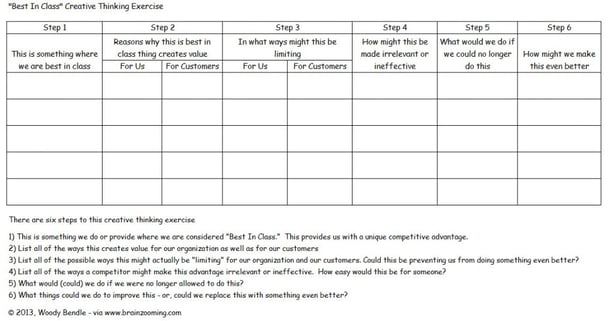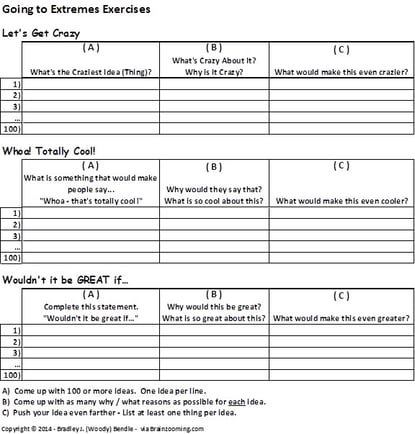Woody Bendle is back with another creative thinking exercise for keeping your best in class products and capabilities truly best in class now and in the future by thinking through how you may really be limited or competitors may be able to attack you. Here's Woody:
"Out there in some garage is an entrepreneur who's forging a bullet with your company's name on it. You've got one option now - to shoot first.” Gary Hamel
 Innovation is an interesting phenomenon. Nearly all businesses exist because at one point or another, they identified an opportunity to create and deliver new value to the market. Whether through a new best in class product or service, entrepreneurs often see unique ways to exploit the vulnerabilities of incumbent firms and as a result, start a new innovative business. However, as the business grows it often puts in place highly efficient, and often inflexible, innovation-killing processes and standards in order to minimize costs and maximize profits.
Innovation is an interesting phenomenon. Nearly all businesses exist because at one point or another, they identified an opportunity to create and deliver new value to the market. Whether through a new best in class product or service, entrepreneurs often see unique ways to exploit the vulnerabilities of incumbent firms and as a result, start a new innovative business. However, as the business grows it often puts in place highly efficient, and often inflexible, innovation-killing processes and standards in order to minimize costs and maximize profits.
I’ve always found this incredibly ironic! The very thing that helped to create this successful business in the first place (innovation) becomes more and more difficult the larger and more successful the business gets. And this is the point that Gary Hamel is making with his quote above; you cannot ever stop innovating. Because once you do, someone is going to eat your lunch – that is an economic certainty!
One of the challenges for companies (in particular businesses in Western cultures) is the notion of “if it ain’t broke, don’t fix it.” Even today with Lean and Six Sigma becoming more and more a corporate norm, Western societies and business still feel that setting out to improve something is a de facto admission that something is broken or wrong. Get over yourselves already, would you?
In today’s markets, if you’re not improving, you’re going out of business – you just might not know it yet.
In order to be successful in today’s, and tomorrow’s market, you have to have the mindset of an innovator and you have to continuously innovate. The era of being able to rest on yesterday’s successes is long gone!
Internal improvements can be innovations!
Over the past 30 years or so, the team from Doblin Innovation Consultants has identified ten types of innovation that they classify into one of three categories:
- Configuration
- Offering
- Experience
Source: Doblin Innovation Consultants
Internally oriented innovations, such as how you choose to align and deploy your resources and how you develop and implement unique processes, can regularly provide incredible value for your firm’s shareholders and customers. These are often stealth innovations your competition can never replicate – even if they do eventually find out what it is that you are doing. And, if you’ve adopted the mindset of continuous innovation and continuous improvement, you will have developed and implemented new best in class practices by the time your competition has replicated your old best practices.
Convinced already? All right! Let’s get to work!
Creative Thinking Exercise for Creating Best in Class
A valuable creative thinking exercise I’ve developed and used with repeated success over the years is one I call “Best In Class.” This exercise is useful for developing ideas for all types of innovations, but I’ve found it particularly valuable for inward facing Structure and Process innovations.
The idea behind the Best In Class creative thinking exercise is to identify and explore the things your organization is currently doing that would be considered best in class; and then develop ideas for making them even better – or even coming up with new ones. This exercise has the following six steps:
1) List all of the things your organization is doing that are best in class.
- These should be things where you are without peer in your category?
2) List the all of the reasons why each is best in class
- What is truly unique about each one?
- How does it provide you a competitive advantage?
- How does it create unique value for your customers?
3) List all of the reasons why each thing might actually be limiting for your business
- Is this preventing you from doing something else that might create more value?
4) Come up with ways that a competitor might make each irrelevant or ineffective
- How easy would it be for someone to also do this and take your advantage away?
- Is someone already doing something to try and take this advantage away from your organization? And if so, how?
5) List things you would do if (for whatever reason) suddenly you were no longer allowed or able to do the thing for which you are best
6) Considering all of the points identified in steps 2-5, how might this Best In Class item be made even better?
The idea with this exercise (as is typically the case with most creative thinking exercises) is to really push yourself and identify as many things as you can where your organization is Best In Class. And for each thing you identify, list as many things as you can within each step. The first things you come up with will be the easiest for you to complete. Eventually, you will feel as if you are running out of ideas; but don’t stop here. I have found over the years the best ideas and opportunities are amongst the last ones that you will generate.
So what do you think? Is this a creative thinking exercise you can see adding to your creativity toolbox? Let me know!
And if you are feeling particularly ambitious, try doing this exercise as if you are that “up and coming” new disruptive competitor in your market. I promise this will be enlightening!
Now let’s get innovating! - Woody Bendle
If you enjoyed this article, subscribe to the free Brainzooming blog email updates.






